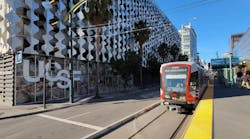Bay Area transit agencies begin syncing schedules
Bay Area transit agencies are now syncing schedules to improve transfers between systems and making schedule changes at the same time. According to Bay Area Rapid Transit (BART), the changes will save riders up to 16 minutes on their trips.
BART notes the schedule changes will occur twice each year, once in summer (mid-August) and once in winter (mid-January). According to the agency, the number of transit agencies with full schedule change alignment (changing schedules at the same time in August and January) has increased from four to 20 since 2022.
The Big Sync reduces travel times
BART says Bay Area transit general managers meet on a weekly basis to make transit more rider-focused and efficient. Agencies meet several months in advance of each schedule change to share planned changes and to look for opportunities to improve transfers.
Specific service coordination efforts for January include:
- BART is timing its late evening Millbrae service that runs every 15 minutes to line up with Caltrain’s service every 30 minutes. In September 2024, Caltrain’s new electric service schedule significantly improved transfer times. BART notes both agencies have coordinated a helpful transfer timetable to show which trains connect and their transfer wait times.
- The Santa Clara Valley Transportation Authority is making changes to match both BART’s and Caltrain’s schedule changes to ensure timed transfers are maintained at various locations across the South Bay and Peninsula.
- San Francisco Municipal Transportation Agency’s Muni is restoring the 30X Marina Express bus for two morning trips at 7:15 a.m. and 7:45 a.m., beginning in February. BART notes morning commuters will be able to enjoy a fast, direct connection from the Marina to BART and the Transbay Center connecting to various bus lines.
- For transit riders traveling during the morning commute from Napa County’s Redwood Park n Ride on the Napa Valley Transportation Authority’s bus 29 to El Cerrito del Norte Station to catch the Red Line into San Francisco between 5:30 a.m. and 8:00 a.m., their trips will be six minutes faster on average and up to 16 minutes faster.
- For transit riders returning home on their evening commute from the San Rafael Transit Center in Marin County to the Richmond Parkway Transit Center in Contra Costa County between 3:00 p.m. and 6:30 p.m. on the Golden Gate Transit #580 or #580X and the Alameda-Contra Costa Transit District #76 (transferring at Cutting Boulevard and Harbour), their trips will be five minutes and 40 seconds faster on average and up to 16 minutes faster.
- Transit riders departing the Salesforce Transit Center between 9:00 p.m. and midnight on the Golden Gate Transit bus 130 and the Marin Transit bus 35 (transferring at the San Rafael Transit Center), will arrive at the Canal Area of San Rafael (Kerner and Larkspur) 15 minutes faster.
“These are examples of how Bay Area transit agencies are acting as one network to better serve the Bay Area to help reduce traffic and improve the quality of service,” said BART Chief Communications Officer Alicia Trost. “Making transit faster than driving a car and easier to navigate is possible when the Bay Area invests in transit and we all work together.”
BART notes Bay Area transit agencies are also working with the Metropolitan Transportation Commission on the upcoming next generation of Clipper, which will give transit riders free or discounted transfers between systems. BART says a unified approach to maps and directional signs across the region is also being tested and expanded, and agencies are participating in Clipper BayPass to test the concept of a prepaid unlimited transit pass and fare capping. According to BART, Clipper BayPass is being sold to interested organizations who would like to offer their employees an all-you-can-ride transit pass, which will help increase transit ridership and meet local and state climate goals.






